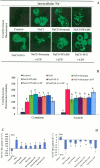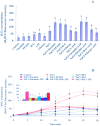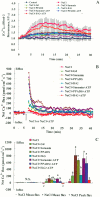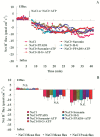Extracellular ATP signaling is mediated by H₂O₂ and cytosolic Ca²⁺ in the salt response of Populus euphratica cells
- PMID: 23285259
- PMCID: PMC3532164
- DOI: 10.1371/journal.pone.0053136
Extracellular ATP signaling is mediated by H₂O₂ and cytosolic Ca²⁺ in the salt response of Populus euphratica cells
Abstract
Extracellular ATP (eATP) has been implicated in mediating plant growth and antioxidant defense; however, it is largely unknown whether eATP might mediate salinity tolerance. We used confocal microscopy, a non-invasive vibrating ion-selective microelectrode, and quantitative real time PCR analysis to evaluate the physiological significance of eATP in the salt resistance of cell cultures derived from a salt-tolerant woody species, Populus euphratica. Application of NaCl (200 mM) shock induced a transient elevation in [eATP]. We investigated the effects of eATP by blocking P2 receptors with suramin and PPADS and applying an ATP trap system of hexokinase-glucose. We found that eATP regulated a wide range of cellular processes required for salt adaptation, including vacuolar Na⁺ compartmentation, Na⁺/H⁺ exchange across the plasma membrane (PM), K⁺ homeostasis, reactive oxygen species regulation, and salt-responsive expression of genes related to Na⁺/H⁺ homeostasis and PM repair. Furthermore, we found that the eATP signaling was mediated by H₂O₂ and cytosolic Ca²⁺ released in response to high salt in P. euphratica cells. We concluded that salt-induced eATP was sensed by purinoceptors in the PM, and this led to the induction of downstream signals, like H₂O₂ and cytosolic Ca²⁺, which are required for the up-regulation of genes linked to Na⁺/H⁺ homeostasis and PM repair. Consequently, the viability of P. euphratica cells was maintained during a prolonged period of salt stress.
Conflict of interest statement
Figures









Similar articles
-
H2O2 and cytosolic Ca2+ signals triggered by the PM H-coupled transport system mediate K+/Na+ homeostasis in NaCl-stressed Populus euphratica cells.Plant Cell Environ. 2010 Jun;33(6):943-58. doi: 10.1111/j.1365-3040.2010.02118.x. Epub 2010 Jan 15. Plant Cell Environ. 2010. PMID: 20082667
-
An ATP signalling pathway in plant cells: extracellular ATP triggers programmed cell death in Populus euphratica.Plant Cell Environ. 2012 May;35(5):893-916. doi: 10.1111/j.1365-3040.2011.02461.x. Epub 2011 Dec 6. Plant Cell Environ. 2012. PMID: 22070751
-
Calcium mediates root K+/Na+ homeostasis in poplar species differing in salt tolerance.Tree Physiol. 2009 Sep;29(9):1175-86. doi: 10.1093/treephys/tpp048. Epub 2009 Jul 28. Tree Physiol. 2009. PMID: 19638360
-
Salinity tolerance of Populus.Plant Biol (Stuttg). 2010 Mar;12(2):317-33. doi: 10.1111/j.1438-8677.2009.00301.x. Plant Biol (Stuttg). 2010. PMID: 20398238 Review.
-
Extracellular ATP signaling and homeostasis in plant cells.Plant Signal Behav. 2012 May;7(5):566-9. doi: 10.4161/psb.19857. Epub 2012 Apr 20. Plant Signal Behav. 2012. PMID: 22516815 Free PMC article. Review.
Cited by
-
Hydrogen Sulfide Mediates K+ and Na+ Homeostasis in the Roots of Salt-Resistant and Salt-Sensitive Poplar Species Subjected to NaCl Stress.Front Plant Sci. 2018 Sep 19;9:1366. doi: 10.3389/fpls.2018.01366. eCollection 2018. Front Plant Sci. 2018. PMID: 30283479 Free PMC article.
-
P2K1 Receptor, Heterotrimeric Gα Protein and CNGC2/4 Are Involved in Extracellular ATP-Promoted Ion Influx in the Pollen of Arabidopsis thaliana.Plants (Basel). 2021 Aug 23;10(8):1743. doi: 10.3390/plants10081743. Plants (Basel). 2021. PMID: 34451790 Free PMC article.
-
Auxin enhances aluminium-induced citrate exudation through upregulation of GmMATE and activation of the plasma membrane H+-ATPase in soybean roots.Ann Bot. 2016 Oct 1;118(5):933-940. doi: 10.1093/aob/mcw133. Ann Bot. 2016. PMID: 27474509 Free PMC article.
-
Quantitative X-ray Elemental Imaging in Plant Materials at the Subcellular Level with a Transmission Electron Microscope: Applications and Limitations.Materials (Basel). 2014 Apr 21;7(4):3160-3175. doi: 10.3390/ma7043160. Materials (Basel). 2014. PMID: 28788612 Free PMC article.
-
Extracellular ATP Acts on Jasmonate Signaling to Reinforce Plant Defense.Plant Physiol. 2018 Jan;176(1):511-523. doi: 10.1104/pp.17.01477. Epub 2017 Nov 27. Plant Physiol. 2018. PMID: 29180381 Free PMC article.
References
-
- Zhang F, Wang Y, Yang YL, Wu H, Wang D, et al. (2007) Involvement of hydrogen peroxide and nitric oxide in salt resistance in the calluses from Populus euphratica. . Plant Cell Environ 30: 775–785. - PubMed
-
- Tracy FE, Gilliham M, Dodd AN, Webb AAR, Tester M (2008) NaCl-induced changes in cytosolic free Ca2+ in Arabidopsis thaliana are heterogeneous and modified by external ionic composition. Plant Cell Environ 31: 1063–1073. - PubMed
-
- Sun J, Wang M, Ding M, Deng S, Liu M, et al. (2010) H2O2 and cytosolic Ca2+ signals triggered by the PM H+-coupled transport system mediate K+/Na+ homeostasis in NaCl-stressed Populus euphratica cells. Plant Cell Environ 33: 943–958. - PubMed
-
- Sun J, Li L, Liu M, Wang M, Ding M, et al. (2010) Hydrogen peroxide and nitric oxide mediate K+/Na+ homeostasis and antioxidant defense in NaCl-stressed callus cells of two contrasting poplars. Plant Cell Tiss Organ Cult 103: 205–215.
Publication types
MeSH terms
Substances
LinkOut - more resources
Full Text Sources
Miscellaneous

